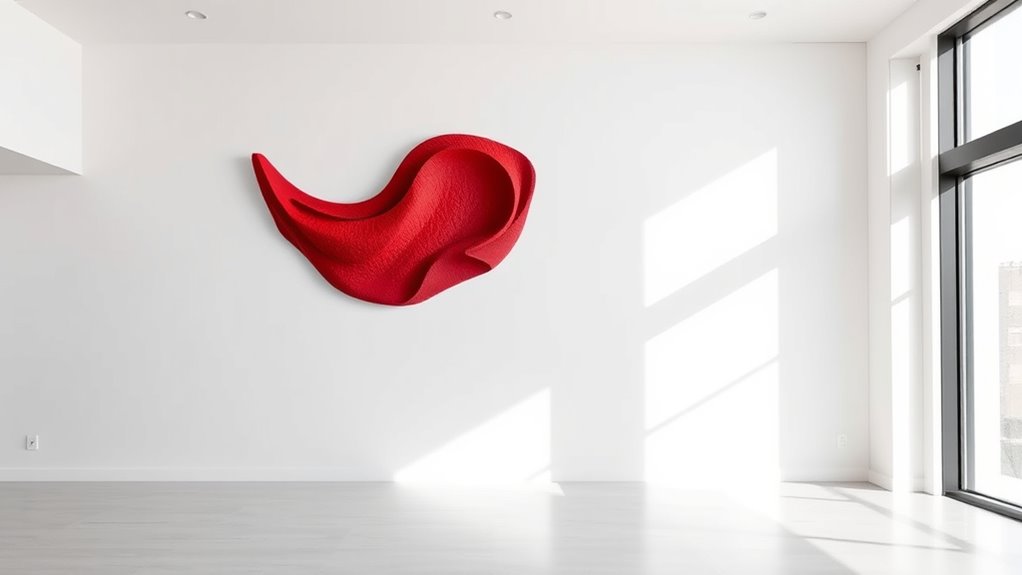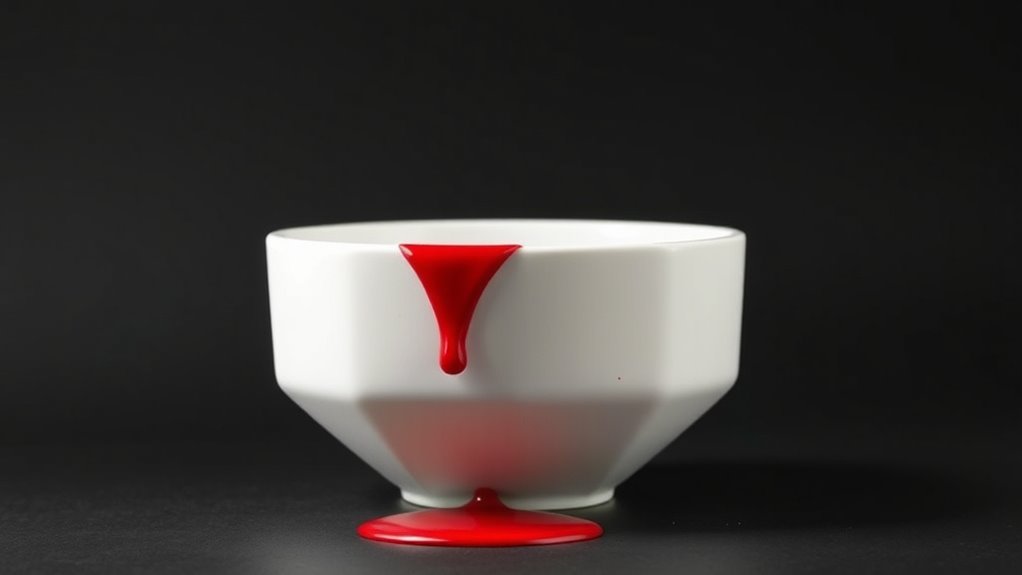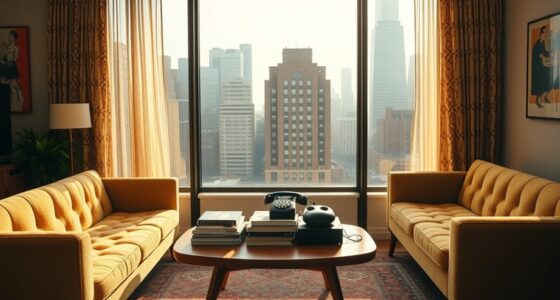Minimalist Maximalism combines simplicity with boldness in a way that feels balanced and vibrant. By using a limited color palette with strategic contrasts, you can highlight focal points without cluttering the space. Focus on giving each piece room to breathe and use large statement items as anchors. This approach challenges traditional design rules, resulting in environments that are both calm and striking. Keep exploring, and you’ll discover how to master this dynamic style effortlessly.
Key Takeaways
- Achieve visual harmony by balancing abundant elements with simple backgrounds to highlight bold statement pieces.
- Use strategic color contrast to emphasize focal points while maintaining a clean, uncluttered environment.
- Incorporate large-scale or sculptural items as focal points, paired with open spaces for a balanced composition.
- Limit color palettes but employ contrasting hues to energize the space without overwhelming it.
- Focus on thoughtful placement and proportion to create vibrant, calm environments that reflect personality.

Have you ever wondered how simplicity and abundance can coexist in design? It might sound like an oxymoron, but in minimalist maximalism, it’s entirely possible. This style embraces boldness without clutter, creating a unique visual harmony that captures attention while maintaining clarity. When approaching this balance, mastering color contrast is key. You can choose a limited palette but make each hue pop through strategic contrast. Imagine pairing a deep navy with a vibrant coral—these opposing tones create instant visual tension that energizes a space. The trick is to use contrast intentionally, highlighting focal points without overwhelming the senses. With careful selection, your design becomes a play of bold and subdued elements that coexist seamlessly. Incorporating active listening and empathy into your design process can help you better understand how different elements work together to create harmony.
Master contrast to blend boldness with clarity in minimalist maximalist design.
Spatial balance also plays a pivotal role in minimalist maximalism. It’s about giving each piece room to breathe, even if the overall design feels abundant. You don’t need to fill every corner; instead, you focus on the placement and scale of each element. Large, statement pieces can act as focal points, while open spaces serve as visual breathing room. This balance prevents the space from feeling chaotic despite its bold features. Think of it like a well-composed painting—each element stands out, but none dominates excessively. When you arrange your objects with intention, you create a rhythm that guides the eye naturally across the room. The key is to strike a harmony between empty space and impactful accents, ensuring your design feels lively yet uncluttered.
In practice, minimalist maximalism invites you to experiment with scale and color vibrancy. Use a few striking items—like an oversized artwork or a sculptural chair—and pair them with simple, clean backgrounds. Play with color contrast not just in objects but also in textiles and wall finishes. For example, a neutral wall makes a bold, colorful piece stand out even more. Simultaneously, think about spatial balance: position your statement piece so it anchors the room, then arrange other elements around it to create a cohesive flow. Even with a bold color palette, maintaining a sense of order and proportion ensures your space remains inviting rather than overwhelming. This approach allows you to enjoy a richly layered environment that feels intentional and vibrant without sacrificing the calmness that simplicity offers.
Ultimately, minimalist maximalism challenges you to see beyond traditional boundaries. It’s about embracing boldness with restraint, using contrast and balance as your tools. When you craft your space with thoughtful color choices and deliberate spatial arrangements, you’ll find that simplicity and abundance aren’t mutually exclusive—they enhance each other, creating a dynamic, captivating environment that reflects your personality and style.
Frequently Asked Questions
How Can I Balance Simplicity and Boldness in My Decor?
To balance simplicity and boldness in your decor, start with clean, minimalist furniture choices that create a calm foundation. Then, add decorative accents like vibrant artwork or statement pieces to introduce boldness without cluttering. Keep the overall color palette neutral or subdued, allowing your accents to stand out. This mix guarantees your space feels both sophisticated and lively, perfectly blending minimalism with maximalist touches.
What Color Schemes Best Suit Minimalist Maximalist Designs?
You might think bold colors clash with simplicity, but in minimalistic maximalist decor, they create striking contrast. Opt for neutral base shades like whites, grays, or beiges, then add accent hues—think jewel tones or vibrant reds—that pop against the calm backdrop. This color contrast highlights your statement pieces without overwhelming the space, allowing both simplicity and boldness to shine seamlessly.
Are There Specific Materials That Enhance This Style?
You should incorporate textured fabrics and metallic accents to enhance this style. Textured fabrics add depth and tactile interest, balancing simplicity with boldness. Metallic accents, like gold or silver, bring a touch of glamour and shine, making your space feel luxurious without overwhelming it. Combining these materials creates a dynamic contrast that captures the essence of minimalist maximalism, making your design both sophisticated and visually engaging.
How Do I Avoid Clutter While Making a Statement?
Imagine a sleek, open space where a single bold statement piece, like a striking sculpture or oversized artwork, commands attention. To avoid clutter, focus on clutter prevention by keeping surfaces clear and only showcasing statement accessories that truly stand out. Select a few impactful items instead of many, balancing simplicity with boldness. This approach creates a visually mesmerizing environment without overwhelming, letting each piece shine and breathe.
Can Minimalist Maximalism Work in Small Spaces?
Yes, minimalist maximalism works in small spaces. You can achieve this by using clever storage solutions like multifunctional furniture and vertical storage to keep clutter at bay. Focus on strategic furniture placement, choosing bold pieces that make a statement without overwhelming the room. This way, you balance simplicity and boldness, creating a lively yet organized space where every item serves a purpose.
Conclusion
You step into a space where clean lines meet daring pops of color, a dance of simplicity and boldness. The quiet elegance of minimalism makes each statement piece stand out, while vibrant accents breathe life into the design. It’s a balance that invites you to breathe easy yet feel energized. As you move through this harmony of less and more, you realize that true beauty lies in embracing both calm and chaos, side by side.









